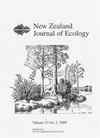Use of constructed rock piles by lizards in a grassland habitat in Otago, New Zealand
IF 1.4
3区 环境科学与生态学
Q3 ECOLOGY
引用次数: 0
Abstract
: The main drivers of lizard population declines in Aotearoa New Zealand are habitat loss and introduced predators. Therefore, habitat enhancement could be useful for mitigating declines, but there is little information on how Aotearoa-endemic lizards respond to these interventions. We examined whether novel habitats created by ten c. 375 m 3 constructed rock piles would be used by McCann’s skinks ( Oligosoma maccani ), southern grass skinks ( O. aff. polychroma Clade 5), and kōrero geckos ( Woodworthia “Otago/Southland large”). The rock piles and their immediate edges were surveyed 22 times between four months and 2.4 years post-construction, resulting in 228 sightings of McCann’s skinks on all ten piles, 20 sightings of southern grass skinks on six piles, and two sightings of kōrero geckos on two piles. Estimated abundance of McCann’s skinks increased over time, and neonates were observed. These observations indicate that rock pile construction could create habitats for McCann’s skinks, but further inference is limited. We recommend that future mitigation programs quantify how habitat construction affects lizard populations and suggest methods for achieving this.在新西兰奥塔哥的一个草原栖息地,蜥蜴使用建造的岩石桩
本文章由计算机程序翻译,如有差异,请以英文原文为准。
求助全文
约1分钟内获得全文
求助全文
来源期刊

New Zealand Journal of Ecology
环境科学-生态学
CiteScore
3.00
自引率
12.50%
发文量
35
审稿时长
>36 weeks
期刊介绍:
The New Zealand Journal of Ecology is a biannual peer-reviewed journal publishing ecological research relevant to New Zealand/Aotearoa and the South Pacific. It has been published since 1952 (as a 1952 issue of New Zealand Science Review and as the Proceedings of the New Zealand Ecological Society until 1977). The Journal is published by the New Zealand Ecological Society (Inc.), and is covered by Current Contents/Agriculture, Biology and Environmental Science, GEOBASE, and Geo Abstracts.
 求助内容:
求助内容: 应助结果提醒方式:
应助结果提醒方式:


